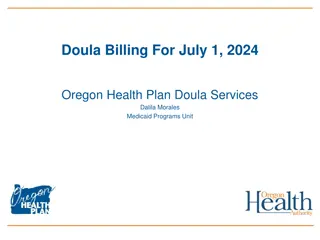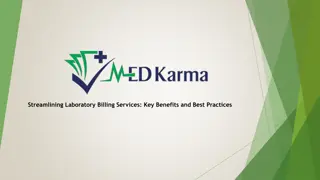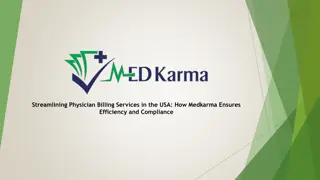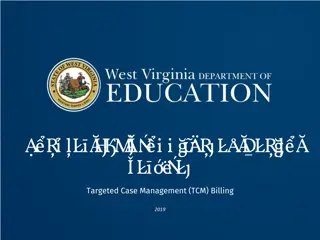Third-Party Billing for Health Services in Minnesota Schools
Minnesota schools can seek reimbursement from insurers for services covered by a child's health insurance starting July 1, 2000. Services include physical therapy, occupational therapy, speech therapy, mental health, nursing, personal care, special transportation, interpreter services, and assistive technology. Personal care assistance providers must meet specific requirements, and eligible recipients should need assistance with daily living activities. The activities of daily living encompass dressing, grooming, bathing, eating, transfers, mobility, and positioning.
Download Presentation

Please find below an Image/Link to download the presentation.
The content on the website is provided AS IS for your information and personal use only. It may not be sold, licensed, or shared on other websites without obtaining consent from the author. Download presentation by click this link. If you encounter any issues during the download, it is possible that the publisher has removed the file from their server.
E N D
Presentation Transcript
WELCOME THIRD PARTY BILLING
Minnesota State Statue Beginning July 1, 2000, districts shall seek reimbursement from insurers and similar third parties for the cost of services provided by the district whenever the services provided by the district are otherwise covered by the child's health coverage.(Minnesota Statute 125A.21).
Billable Services PHYSICAL THERAPY OCCUPATIONAL THERAPY SPEECH THERAPY AND AUDIOLOGY MENTAL HEALTH (CTSS) NURSING PERSONAL CARE SERVICES (PCA) SPECIAL TRANSPORTATION INTERPRETER SERVICES ASSISTIVE TECHNOLOGY
Personal Care Services (PCA) Qualified Providers To be eligible to provide personal care assistance, the person must meet all of the following requirements: Successfully completed the required DHS online training and certification. DHS online training & certification link: http://registrations.dhs.state.mn.us/videoConf/Default.aspx?BusinessUnitID=16 Receive training and supervision from a qualified professional (QP) on how to meet the child s or youth s needs Have the ability to effectively communicate with the child or youth and with the QP who is providing training and supervising the health-related PCA services the child or youth receives during the school day Be able to effectively provide PCA services according to the child s or youth s PCA plan of care Be able to appropriately respond to the child s or youth s needs and immediately report significant changes in the child s or youth's condition to the supervising QP Maintain required daily written records including, but not limited to, PCA activity check lists or logs, and communication with the QP and emergency contacts Be employed by the school district to provide PCA services or be under contract with an agency that has a PCA service agreement with the district
Eligible PCA Recipients To be eligible for PCA services in school, the child or youth must be dependent and need assistance for one or more of the activities of daily living (ADL), or require intervention or redirection from another person for level 1 behaviors.
Activities of Daily Living Activities of daily living include health and hygiene needs that are part of daily living, as well as activities integral to the activity. ADLs include the following: Dressing: Assistance with choosing, putting on and changing clothing and with application of special appliances, or clothing. Grooming: Assistance with basic hair care, oral care, shaving, applying cosmetics and deodorant; ensuring clothes are properly fastened; and care of eyeglasses and hearing aids (confirming batteries work, positioning aids). Bathing: Assistance with basic personal hygiene and skin care. Eating: Assistance with hand washing and applying orthotics required for eating, as well as transfers and feeding. Transfers: Assistance with transferring the child or youth from one seating or reclining area to another. Mobility: Assistance with ambulation, including use of a wheelchair. Positioning: Assistance with positioning or turning a child or youth for care and comfort. Toileting: Assistance with bowel or bladder elimination and care, including transfers, mobility, positioning, feminine hygiene, use of toileting equipment or supplies, cleansing the perineal area, inspection of the skin and adjusting clothing.
Level 1 Behavior A child or youth qualifies as having the need for assistance from a personal care assistant through observation, redirection or intervention of a behavior episode if the episode is due to a medical or mental health condition and requires the immediate response of another person to prevent injury to self or others, or damage to property. Behaviors may occur at different levels and in different situations. To qualify for PCA services, the display of a level 1 behavior must be current, and determined to be either daily or episodic and ongoing (for example, four times a week).
Level 1 Behavior Defined Level 1 behaviors are defined as: - Physical aggression toward self (self-injurious behaviors) - Physical aggression toward others (physical injury to others) - Destruction of property Examples of level 1 behaviors: Physical Aggression towards self Physical Aggression towards others Destruction of Property Hitting, biting or burning self Hitting Breaking furniture Head banging or pulling hair Biting Tearing clothes Poking or stabbing oneself Scratching Setting fires Ingesting foreign substances Kicking Using tools to cause property damage Suicide threats Pinching
Additional Billable PCA Services Once a child or youth qualifies for PCA services, he or she may also receive assistance from a personal care assistant for redirection or intervention during a behavioral episode, when the child or youth displays increased vulnerability due to cognitive deficits or socially inappropriate behaviors, and for other delegated health-related procedures and tasks. The increased vulnerability due to cognitive deficits or socially inappropriate behavior of a child and youth who is verbally aggressive or resistive to care must relate back to: The medical need of the child or youth Whether the need would otherwise prevent the child or youth from attending school Whether the behavior would put the child or youth, another person or property in harm s way that is beyond what is expected for the child s age
Additional Billable PCA Services Once a child or youth qualifies for PCA services, he or she may also receive assistance from a personal care assistant for redirection or intervention during a behavioral episode, when the child or youth displays increased vulnerability due to cognitive deficits or socially inappropriate behaviors, and for other delegated health-related procedures and tasks. Document delegation of health-related procedures and tasks and training in the PCA plan of care for the child or youth and in the file of the person providing the PCA services. These PCA services include, but are not limited to the following: Range of motion and passive exercise to maintain a child s or youth's strength and muscle function Assistance with self-administered medication, including reminders to take medication, bringing medication to the child or youth, and assistance with opening medication containers; including medications given through a nebulizer. Interventions for seizure disorders that occur more than two times per week and require physical assistance to maintain safety Procedures for complex health-related needs, including tracheostomy suctioning, services to a child or youth needing ventilator support and other direct cares. These are covered PCA services if delegation, training and supervision is by a registered nurse (RN).
PCA Time Study PCA time studies: Should be created based on the services identified in the child s IEP or IFSP and the child s current plan of care Must be completed by a trained PCA who has or will work with the child throughout the school day Conducted over a 10-day period. Document each task or behavior episode, and the start and end times for each task or behavior episode Must calculate the average daily time for each task, and the total daily time for all PCA services combined. Should accompany the Plan of Care
PCA Plan of Care A PCA care plan is a written description of each of the medically necessary PCA services a child will need during the school day with specific instruction of how the services should be provided. The plan of care must be developed by a QP working within their scope of practice. A QP is also responsible for the training and supervision of the person who will be providing the service to the child. The plan of care may be embedded within the child s IEP or IFSP, or may be provided as a separate document. The IEP or IFSP must have a statement indicating the IEP or IFSP is serving as the PCA plan of care or that the plan of care will be maintained as a separate document. A copy of the most current PCA plan of care must be immediately available to the person who is providing the PCA services.
Plan of Care- Required Components Components of a PCA plan of Care must include: Start and end date of the plan of care Child s name, student identification number, date of birth, demographic information including name of parent, guardian or responsible party, and emergency contact information List of special instructions or procedure required to meet the child s specific requests or needs, such as meeting the communication needs of the child due to a language barrier or whether the child or family has requested a personal care assistant of a specific gender A clear summary including the diagnosis, condition, sign or symptom that is creating the need for the service Identify the ADL s, level 1 behaviors or health related tasks the child will need Steps to address safety and vulnerability issues of the child or youth, including but not limited to, responding to immediately predictable, identifiable triggers to level 1 behavior episodes Date, name and signature of the QP
Electronic Documentation Demonstrate SCHOOL Project K12 Application
PCA Questions Any questions or comments . PART 2: Is intended for Qualified Providers/Supervisors of PCA
14-90-120 Evaluations Initial Evaluation: The QP must complete an initial evaluation of the personal care assistant through direct observation of the personal care assistant s work within the first 14 days of starting to provide regularly scheduled services to the child or youth. After the initial evaluation, subsequent visits do not require direct observation of each person providing PCA services unless determined by the QP based on the needs of the child or youth and the personal care assistant s ability to meet those needs. Periodic Evaluation: The QP must complete periodic evaluations as follows: At least every 90 days for the first year of service to the child or youth. After the first two 90-day evaluations (total of 180 days) of a PCA providing service to the same child, the supervisory visits may alternate between unscheduled phone or internet technology and in-person visits, unless the in-person visits are needed according to the care plan Every 120 days in the second and succeeding years that the same person is providing the PCA services to the same child Sign, date and indicate the supervision visit on the PCA activity checklist when a periodic evaluation and supervision visit is conducted during the period identified on the activity checklist.
Documentation of Evaluations At the initial and each periodic supervisory visit, the QP must evaluate whether the PCA services: Meet the needs of the child or youth as identified in the IEP or IFSP Help the child or youth participate in and benefit from regular and special education The QP evaluation must include review and documentation of the following: Satisfaction level of the child or youth and parent or guardian with the PCA services Adequacy of the tasks and activities in the PCA plan of care to meet the needs of the child or youth The personal care assistant s understanding of the child s or youth s needs, knowledge of the care plan The personal care assistant s demonstrated ability to competently carry out the tasks to meet the needs of the child or youth as trained Documentation by the personal care assistant of the services provided, the personal care assistant s communication with the QP and emergency contacts made, if any Changes in the needs of the child or youth requiring change in the level of service, revision of the PCA care plan or additional training of the person providing PCA services At the conclusion of the evaluation, the QP must document the above and the following: Actions necessary to correct any deficiencies in the work of a person providing PCA services. Hands-on training or individualized training for the care of the child or youth that was conducted or assignments and timeline for training to occur Revision of the PCA plan of care as necessary to meet the needs of the child or youth























